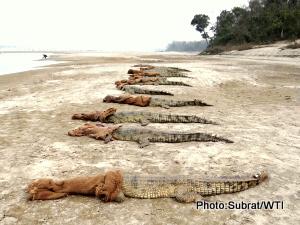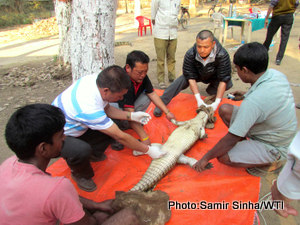Released Gharials Meet the Wild Ones, 12 More Released
Valmikinagar, February 11, 2015: The captive bred and reared Gangetic gharials (Gavialis gangeticus) released in the Gandak River last month have been sighted with the resident individuals of the species in the river. The released individuals are using the same area which the wild individuals have been using for the last few years. As a part of the Gharial Restocking Project of the Environment & Forest Department, Government of Bihar, 12 gharials were released in Gandak River on January 21, 2015. The project is technically supported and implemented by Wildlife Trust of India (WTI) since March 2014.
After 10 days of their release, WTI field team monitoring the gharials noticed one of the individuals basking on the sandy banks with a wild gharial who has been seen in that particular location for the last few years. Some more wild gharials were sighted at this particular stretch, where the released gharials have currently settled down. This indicates that the reintroduced gharials have identified the suitable habitat which is almost three kms downstream of the release site.
Furthermore, a third batch of 12 gharials — one male and 11 sub-adult female — was released in the river on February 11, 2015. This batch was sourced from Sanjay Gandhi Biological Park (SGBP), Patna, and released in the Gandak River in presence of RB Singh, Field Director, Valmiki Tiger Reserve, along with other forest officials, WTI staff, and SGBP veterinary team.
Under this particular project, 30 gharials have been released till now in the Gandak River, which is a historic distribution range of the species. Incidentally, captive breeding of gharials in the country was initiated with the clutch of eggs collected from the same river in early 1970s. The river forms western boundary of Valmiki Tiger Reserve for about 50 km and a large stretch of the river is relatively less disturbed from anthropogenic activities, which is crucial for establishing the population of critically endangered gharials.
Moreover, under a Rapid Action Project (RAP) undertaken as part of IFAW-WTI’s Bhutan Trans Boundary Initiative, three staff members of the Wildlife Rescue Staff from Bhutan’s Phuentsholing Crocodile Centre visited the Patna Zoo for training in handling gharials. The training was carried out on the request of Bhutan’s WCD, DoFPS, and since the Phuentsholing Centre in Bhutan too is overcrowded with crocodiles and gharials, the department is planning to relocate them to Jigmeling, Gelephu, Bhutan. Since the Bhutanese team lacks experience in handling crocodiles and gharials, the department felt that they need training before they commence relocation.
The visitors learnt how to capture and do sex identification on gharials from the IFAW-WTI’s project team before the animals were released in Gandak River. IFAW-WTI’s Wild Aid Division catered to this particular need and decided to help them in whatever possible way.












